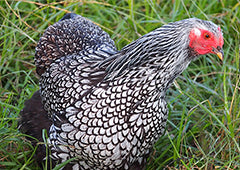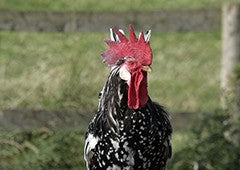The Red Jungle Fowl is thought to be the ancestor of the domestic chicken. The jungle fowl was domesticated over 5,000 years ago in Asia and has since spread around the world. The red Jungle fowl is a renowned dual-purpose breed.
HISTORY
- Origin: Asia
- Size: 1.3-2 kg
- Rarity: Common
- Five recognized Variations: the Indian red Jungle Fowl, the Burmese red jungle fowl, the Tonkinese red jungle fowl, the Cochin-Chinese red jungle fowl, the Javan red jungle fowl.
EGG FACTS
- Tinted
- 250-300 Eggs Average Annually
FEATURES
Male and female Red Jungle Fowls show very strong sexual dimorphism. Males are much larger; they have large red fleshy wattles and comb on the head and long, bright gold and bronze feathers forming a "shawl" or "cape" over the back of the bird from the neck to the lower back. The tail is composed of long, arching feathers that initially look black but shimmer with blue, purple and green in good light. The female's plumage is typical of this family of birds in being cryptic and having evolved for camouflage as she alone looks after the eggs and chicks. She also has no fleshy wattles or comb on the head.
BACKYARD BEHAVIOUR
- Hardy in Winter: Yes
- Especially Docile: No
- Personality: Males make a food-related display called 'tidbitting', performed upon finding food in the presence of a female. The display is composed of coaxing, cluck-like calls and eye-catching bobbing and twitching motions of the head and neck. During the performance, the male repeatedly picks up and drops the food item with his beak. The display usually ends when the hen takes the food item either from the ground or directly from the male’s beak and is associated with copulations and more offspring. Males produce anti-predator alarm calls.
You might be looking for hardy hens like the Red Jungle Fowls or for a more docile breed like the soft Silkies. Deciding to become a chicken parent is the easy part. The hardest is deciding on your favourite breed! There are so many amazing breeds to consider when starting your own flock. It can be eggstremely overwhelming to find the perfect breeds for you and your family. From looks, to traits to egg-laying talents - where should you begin?
Cluckily, our friends over at Chickenpedia have created an amazing Chicken Breeds Course. This extensive online course shares useful advice on choosing the right chickens for you as well as size & frequency of eggs laid. You’ll even learn about their individual personalities, and be able to use their family-friendly compatibility scale through this well-structured program. It really is a great way to find your perfect backyard buddies which is why I highly recommend them to all of my readers! The courses are beginner-friendly and filled with vital information to help you raise a happy, healthy flock.
As chicken keepers, we want to do an eggcellent job when caring for our feathered friends. Unfortunately, many of us struggle to handle chicken health or behaviour issues, especially in the first few years of having a flock. Chickenpedia have a full range of comprehensive online courses that cover everything you didn’t know you need to know and then some more! From healthcare to raising baby chicks to feeding and behavior, get the knowledge and confidence to successfully look after your chickens like an eggspert.
As a member, you will get access to ALL their fantastic courses. So, no need to wing it, become a confident chicken keeper. Click here to check out Chickenpedia today!


















